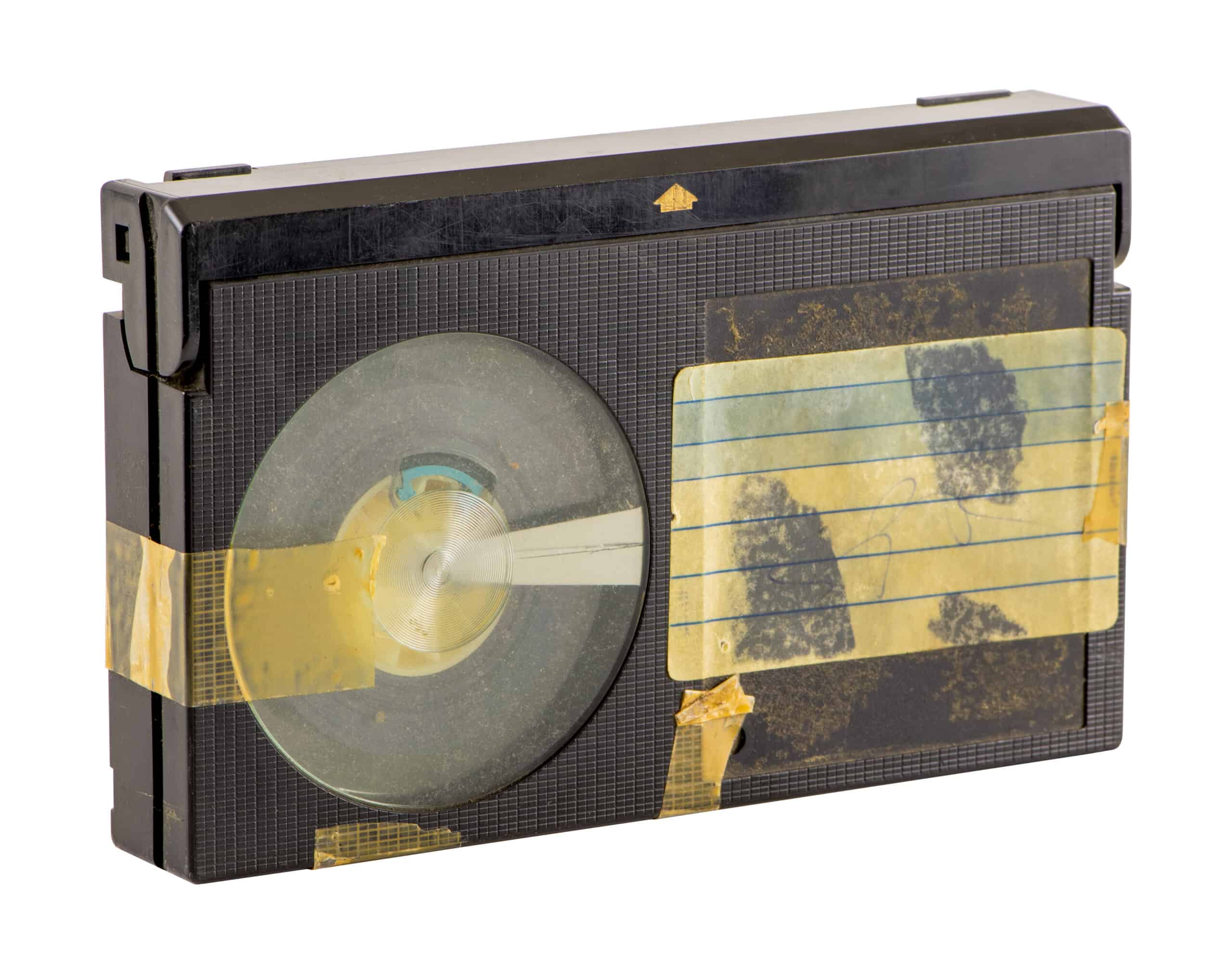When you think of video cassettes, you likely think of a VHS—that little rectangular brick of black plastic and magnetic tape with the little see-through windows on the front.
However, VHS tapes didn’t just become synonymous with video cassettes for nothing. As it turns out, there was a lot of work involved.
Quick Facts
- Year Founded
- 1975
- Founders
- Sony
- Industry
- Home video
- Notable Products
- Betamax, Beta Tape, Betacam
Betamax, the rival video cassette format that set off the videotape format war in the late 1970s and into the 1980s tried to give VHS a run for their money.
Ultimately, though, they failed miserably.
But, where did Betamax come from? What was it about their format and fanbase that threatened to dethrone the VHS? How did its specs look? And, maybe most importantly, what was the real reason why Betamax failed?
Let’s break everything down below, beginning with the starting significance of Betamax, in order to find answers to these questions. In the end, we’ll have a much better idea of why Betamax failed so spectacularly.
The Significance of Betamax
Despite what you might think, given its lasting legacy, the VHS tape actually came second to the Betamax tape.
There’s a two-year difference in the release dates of the two tape formats, with Betamax arriving in the US in 1975 and VHS arriving in 1977. This is one of the largest reasons why Betamax was such a big deal at the time: It was groundbreaking technology for 1975, allowing users to easily record and play back video via magnetic tape.
Also referred to as Beta Tape, this new technology allowed for up to two hours of recording at the outset. There was a handful of other features exclusive to Beta Tape in these early, pre-VHS years, including a high-speed picture search called BetaScan and a fast-forward and rewind option called BetaSkipScan.
For those two years, Betamax and the Beta Tape reigned supreme. There was very little competition, if any at all, making their success a no-brainer (after all, it’s easy to come in first when running unopposed, right?). However, the emergence of the VHS in 1977 and its many significant improvements over the Betamax and its core features almost immediately spelled out trouble for the brand of video cassette tapes.

©iStock.com/PoppyPixels
Betamax’s Popularity Among Professionals
One area where Betamax saw a particularly large amount of popularity was in the music and video production industries.
Sony, the mastermind (or the fool, depending on your perspective) behind Betamax was wise enough to create and market a suite of industrial-sized Beta Tapes for use in music and video production. Luckily for them, it caught on and stuck for longer than commercial Betamax products ever did.
For broadcasting and film and television production, Sony tweaked Betamax to create the Betacam. By 1982, the Betacam was the most used, most trusted format for electronic news gathering.
While Betacam and Betamax are not exactly identical, Sony’s decision to base the Betacam on some of the most vital aspects of the Betamax proved to be a good thing for the struggling video cassette format.
Beyond the Betacam, there was also the PCM: a Betamax-adjacent recording system designed for use in the music recording industry. Short for pulse-code modulation, the PCM hooked up to a Betamax recorder and allowed sound engineers to make digital master recordings straight onto Beta Tape.
It remained one of the most popular recording formats in the music industry well into the 1990s.
Betamax Specs
| Name | Betamax, Beta Tape |
| Type of Media | Magnetic cassette tape |
| Use | Home video |
| Developer | Sony |
| Release Date | May 10th, 1975 (Japan), November 1975 (U.S.) |
| Encoding | NTSC, PAL, SEAM |
| Maximum Capacity | 5 hours |
| Video Quality | 250 lines (333 x 486 px) |
| Read/Write Mechanism | Helical scan |
| Size | Approx. 6 x 4 x 1 inch |
| Successor | VHS |
| Discontinued | 2002 (recorders), 2016 (tapes) |
Betamax: The Complete History
The name Betamax derives from two different places: “Beta” is the Japanese word for how signals are recorded on a tape, and the Greek letter for “beta” looks like a cassette tape traveling through a transport. “Max,” on the other hand, was merely thrown on the end for marketing purposes, meant to signify maximum audio-visual quality.
The very fist Betamax product in the United States was the LV-1901, a console with a 19-inch color monitor and 1/2-inch wide videotapes. Released in November of 1975, the LV-1901 was unlike anything else on the market. The only thing that even came close to comparing was the U-matic, a simple, rudimentary videotape that was much thicker in size and poorer in quality.
Betamax was distinct for its lack of a guard band and its attempt to cut down on crosstalk, where multiple audio signals are read at once during playback.
Until the VHS tape hit the market in 1977, Betamax was the only tape in the game to try and resolve this longstanding issue with cassette tapes.
Early Signs of Imminent Failure
The trouble began almost immediately.
Similar to the war that broke out between HDDVD and Blu-ray in the late 2000s and early ’10s, Sony had hoped that the video cassette tape industry and all other manufacturers would simply adopt the Beta Tape as the standard industry format.
Unfortunately for them, this just didn’t happen. JVC, a Japanese-owned rival brand decided to create their own format. This was what eventually became the VHS.
With this simple action, it was an all-out war.
Remember those features that made Betamax unique? The lack of a guard band, its anti-crosstalk measures, BetaScan, and BetaSkipScan? Well, JVC’s answer to the Betamax, the VHS tape, attempted to recreate all of this with their product.
While they weren’t totally successful in replicating all of Betamax’s features – especially BetaSkipScan, which proved to be especially tricky – the fact that they managed to tap into Betamax’s most distinct features struck fear into the hearts of Sony executives.
It wasn’t the final nail in the coffin, though. It was merely the first.

©iStock.com/mrdoomits
The Eventual Demise of Betamax
As the VHS emerged on the market as a serious competitor, the folks behind Betamax struggled to keep them at bay.
What was once so revolutionarily distinct was now being copied and pasted onto another company’s nearly identical product, leaving Sony grasping at straws struggling to think of a way to fight back.
Pricing played a huge part here. When Sony and JVC’s technology looked nearly indistinguishable to the naked eye or the inexperienced consumer, the actual cost of the technology became one of the easiest ways to mark the difference between the two.
Betamax had a marginally better recording quality and a slightly better sound compared to the VHS, putting it at a higher price tag. However, these differences weren’t all that noticeable to the average consumer, meaning they leaned toward VHS almost every time.
Further advancements to the VHS tape led to the slow, steady unseating of its rival predecessor. In time, Betamax failed to keep up with all that VHS had to offer.
But, why did this happen when things were looking so promising at the start? There are a few possible answers.
Why Betamax Failed
When Betamax failed, it failed hard. How does a company go from dominating 100% of the market in 1975 to under 7.5% a decade later?
In Sony’s case, it seemingly all came down to marketing. In hindsight, it’s clear that Sony seriously misjudged how to market to home video consumers. They (somewhat foolishly) believed that it would be totally fine to cap Beta Tapes at one hour, which was the standard set by their predecessor U-matic.
They didn’t consider the fact that one hour was practically nothing when consumers would want to try to record sporting events, feature films, or primetime television blocks.
Another marketing misstep came from the product’s pricing. Betamax was superior in look and sound to the VHS, warranting its higher price. However, this higher price put VHS at an advantage despite its slightly poorer quality. Sony didn’t consider that their increased quality was barely even noticeable, making the choice of VHS an obvious, more budget-friendly decision.
In a last-ditch effort to win out over VHS, Betamax made several serious upgrades to their technology. They introduced high-fidelity audio with Beta HiFi. Then, they improved bandwidth with SuperBetamax. They even tried higher definition with ED-Beta. Even with all this, it just wasn’t enough.
Sony’s misjudgment and their insistence on charging more than their competitor ultimately led to their demise.
Why Did VHS Succeed?
While Betamax failed, VHS succeeded.
Despite Betamax’s better quality, the lower price of the VHS and compatible VCR players led to a seriously unbeatable advantage over all the other competitors and their video cassette tapes. Consumers wanted affordable products more than they wanted high-quality tapes and players, and this can be seen in the VCR’s continued relevance. The name VHS brings to mind an image that the name “Betamax” just doesn’t for most.
Some have another theory as to why VHS triumphed over Betamax, and it’s just crazy enough to be believed (even if it is a little… mature).
See, because VHS was cheaper than Betamax, not only for consumers but also for filmmakers and home video companies, it’s believed that VHS’s much larger library of adult films gave the rival format a huge leg up over Betamax. (This is similar to the theory as to why Family Video was able to survive so much longer than rival video rental stores: They kept their adult film section up and running all the way till the bitter end).
All in all, it seems VHS succeeded and Betamax failed due to a combination of factors: price, selection, availability, and access.
It’s eerie how similar Betamax’s loss to VHS is to the HDDVD vs. Blu-ray debate: While HDDVD came first, Blu-ray eventually came out on top.
Let it be a lesson for all future home video formats.
Up Next
- The 5 Best Projectors You Can Buy Today
- Roku vs Fire Stick: Full Comparison with Pros, Cons, and Features
- 1080p vs. 4k – Full Comparison
- The 10 Best Movies About Robots
The image featured at the top of this post is ©iStock.com/Mehmet Gökhan Bayhan.


